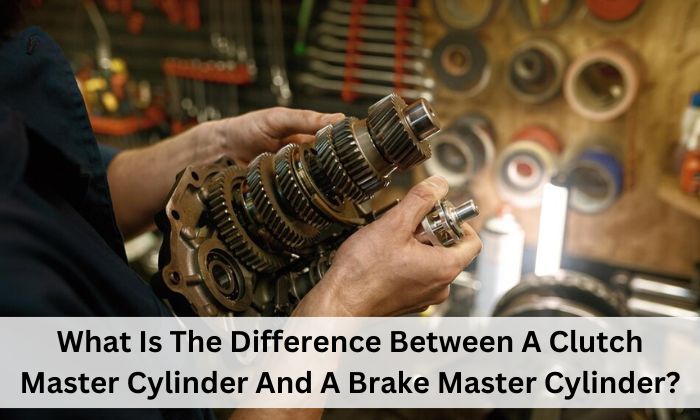A master cylinder is essential to vehicle hydraulics. It converts mechanical force into hydraulic pressure, the primary source. The clutch and brake master cylinders are necessary for smooth functioning. These systems would fail without a working master cylinder.
| Difference | Description |
| Design and Size | Clutch master cylinders are smaller and compact. |
| Pressure Requirements | Clutch master cylinders operate at lower pressures. |
| Fluid Type | Brake systems often use specialized brake fluid. |
| Functionality | Clutch master cylinders engage and disengage clutch. |
| Operating System | Brake master cylinders are part of hydraulic braking. |
What Is A Clutch Master Cylinder?
The clutch master cylinder is manual transmission-specific. It primarily transmits hydraulic pressure to engage and release the clutch. As the clutch pedal is pushed, hydraulic fluid from the clutch master cylinder goes via the clutch line to the slave cylinder, disengaging the clutch. Manual transmission drivers must understand the clutch master cylinder function.
What Is A Brake Master Cylinder?
Brake master cylinders are essential to automobile braking systems. It transfers brake pedal power into hydraulic pressure for brake calipers or wheel cylinders. The car stops when hydraulic pressure drives the brake pads or shoes facing the rotors or drums. The brake master cylinder is essential for safe and dependable braking.
Key Differences Between Clutch And Brake Master Cylinders
1. Design And Size:
Due to their system requirements, clutch and brake master cylinders range in design and size. Most clutch master cylinders are more miniature than brake ones. Each system requires different hydraulic pressure and fluid volume, causing this disparity.
A smaller master cylinder is needed in manual transmission vehicles because the clutch mechanism functions with less pressure. However, brake master cylinders must create more pressure to push brake calipers or wheel cylinders, thus increasing their size. The clutch and brake master cylinders’ different functioning systems highlight their size differences.
Since they merely activate or disengage the clutch mechanism using hydraulic pressure, clutch master cylinders are simpler. Brake master cylinders must create enough power to stop the car, needing a more oversized piston and reservoir to handle the fluid volume and pressure.
2. Pressure Requirements:
Another distinction between clutch and brake master cylinders is pressure. Due to their systems, clutch master cylinders function at lower pressures than brake master cylinders. A manual transmission vehicle’s clutch needs less hydraulic pressure to engage or disengage smoothly. Since the clutch master cylinder must supply pressure within a limited range, it frequently has a smaller piston and diameter.
In contrast, brake master cylinders create more significant pressures for better braking. The brake master cylinder amplifies mechanical force into hydraulic pressure when the brake pedal is pushed. Hydraulic pressure forces brake calipers or wheel cylinders to compress brake pads or shoes against rotors or drums. Thus, brake master cylinders have bigger pistons and bores to handle the higher braking pressure.
Clutch and brake master cylinder maintenance and troubleshooting need knowledge of these pressure variances. It helps technicians and vehicle owners detect and fix problems quickly, assuring the hydraulic system’s dependability and safety.
3. Fluid Type:
The hydraulic fluid used by clutch and brake master cylinders may also vary. Both systems use hydraulic fluid to convey pressure while braking systems use specialist brake fluid with additives to endure high temperatures and function well under different environments. DOT (Department of Transportation) brake fluid comes in grades 3, 4, and 5 with varying properties for various vehicle uses.
Clutch systems may utilize a different hydraulic fluid, but vehicle compatibility is essential. Some cars use the same clutch and brake fluid, while others need separate formulas. Both clutch and brake master cylinders need frequent fluid flushes and replacements at set intervals to work correctly and last.
4. Functionality:
Manual transmission clutch master cylinders deliver hydraulic pressure to activate and release the clutch mechanism. The master cylinder pressurizes hydraulic fluid via the clutch line to the slave cylinder, disengaging the clutch from the engine flywheel when the clutch pedal is pushed. When the clutch pedal is liberated, the clutch engages, and power is transferred from the engine to the gearbox.
In contrast, a brake master cylinder turns brake pedal energy into hydraulic pressure to operate brake calipers or wheel cylinders, slowing or halting the vehicle. The master cylinder increases the brake pedal power and supplies hydraulic fluid to the brake assemblies, pressing the brake pads or shoes against the rotors or drums. Friction provides the stopping force needed to slow or stop the vehicle for road safety.
5. Operating System:
Different vehicle operating systems use clutch and brake master cylinders. Manual transmission systems use the clutch master cylinder to activate and release the clutch. It works with the clutch pedal, slave cylinder, and release bearing to smooth engine-transmission power transfer.
However, the brake master cylinder is vital to the hydraulic braking system, which slows or stops the car when the brake pedal is applied. The brake master cylinder and brake lines, calipers, and rotors enable precise control and dependable braking in varied driving circumstances. Vehicle maintenance and repair need knowledge of clutch and brake master cylinder functioning systems and components to resolve faults and optimize performance and safety quickly.
Maintenance And Troubleshooting
Master cylinders need regular maintenance for safety and performance. Checking fluid levels, leaks, and seals and hoses is part of this. Spongy pedals and pressure loss are frequent master cylinder concerns that need a systematic strategy to diagnose and fix. Maintaining and troubleshooting the vehicle’s brake and clutch systems helps avoid expensive repairs and guarantee their dependability.
Conclusion
Vehicle owners and enthusiasts must understand clutch and brake master cylinders. Both components perform comparable functions but work in separate systems with different designs. Drivers may maintain vehicle safety and dependability by learning to operate and maintain these critical components.
FAQs
What Is The Main Function Of A Clutch Master Cylinder?
In manual transmission automobiles, a clutch master cylinder transmits hydraulic pressure to activate and release the clutch. Pressing the clutch pedal pressurizes hydraulic fluid in the clutch master cylinder, which goes to the clutch slave cylinder to release the clutch and enable gear changes.
How Does A Brake Master Cylinder Work?
The brake master cylinder transfers pedal energy into hydraulic pressure for the braking calipers or wheel cylinders. With the brake pedal pushed, the master cylinder forces brake fluid through the brake lines to activate the brakes. Hydraulic pressure frictions brake pads or shoes, slowing or halting the vehicle.
Can I Use The Same Hydraulic Fluid Type For Clutch And Brake Master Cylinders?
Both clutch and brake master cylinders use hydraulic fluid to convey pressure, although they may use various kinds. A specialist brake fluid with additives improves performance and temperature resistance. The vehicle’s handbook or a trustworthy technician must be consulted to ensure compatibility with the clutch and braking system.

